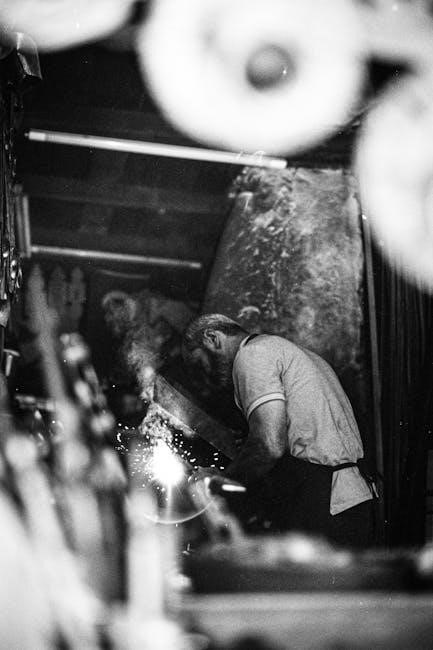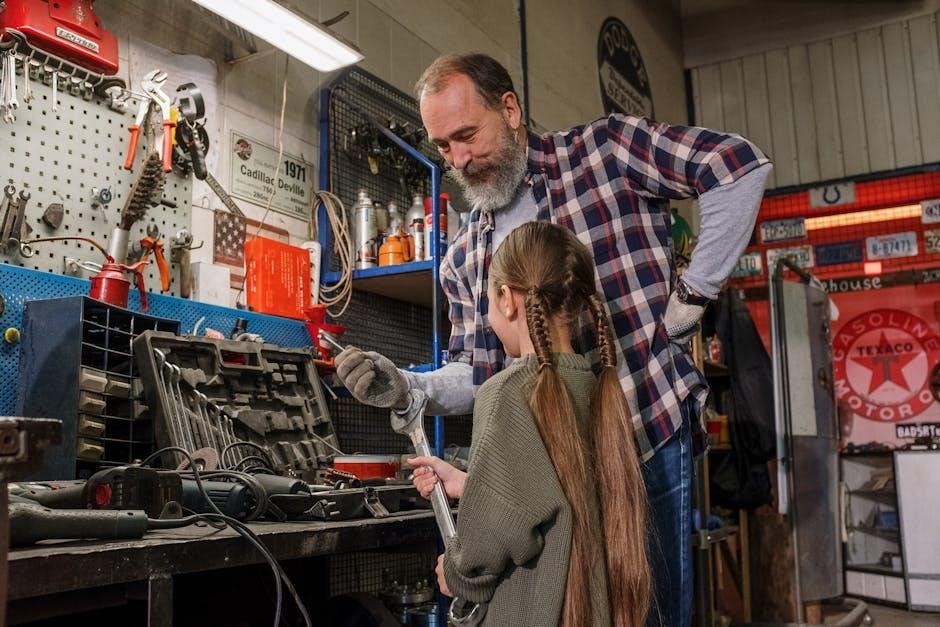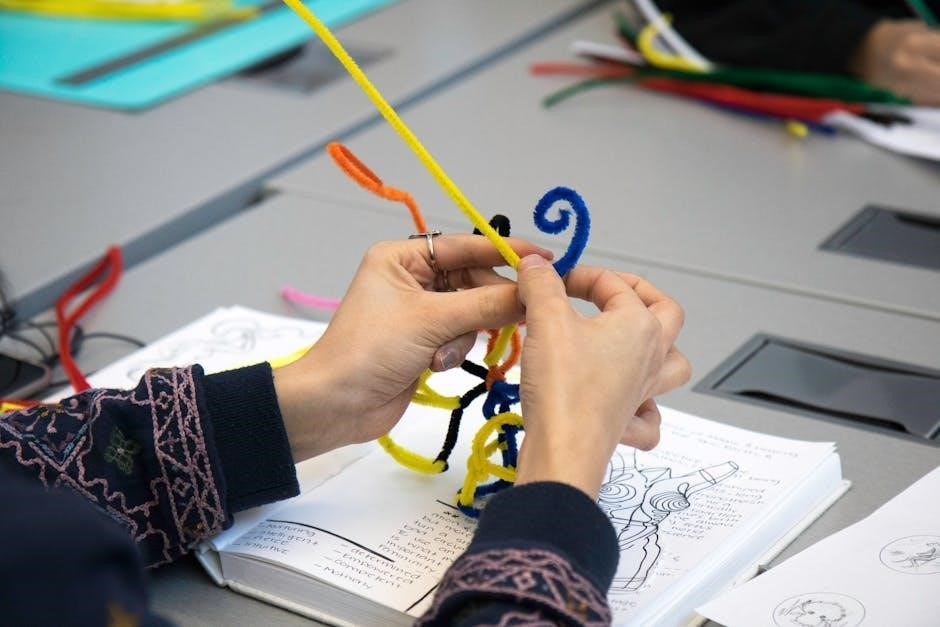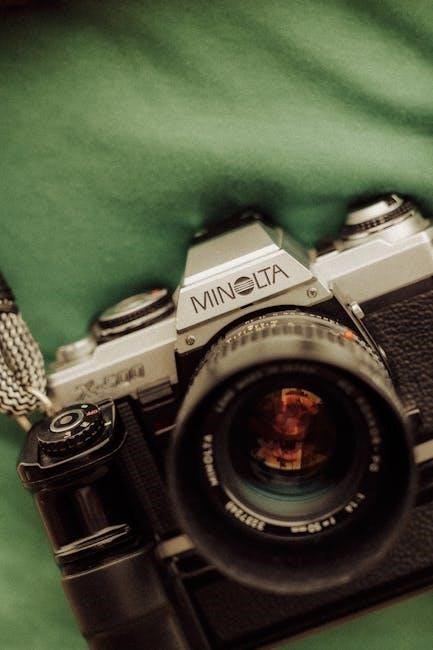The Minolta Maxxum 7000, released in 1985, revolutionized photography as the first camera with an in-built film advance motor, offering unparalleled ease of use and innovative features. Its instruction manual remains a vital resource for photographers, providing clear guidance on mastering its advanced functionalities and ensuring optimal results in various shooting scenarios.
Overview of the Minolta Maxxum 7000
The Minolta Maxxum 7000, introduced in 1985, was a groundbreaking 35mm SLR camera that revolutionized photography with its innovative features. It was the first camera to incorporate an in-built motorized film advance system, enabling faster and easier film loading and advancing. This feature, along with its advanced autofocus capabilities, made it a favorite among both professional photographers and hobbyists. The camera also offered versatile shooting modes, including aperture priority, shutter priority, and metered manual modes, providing users with creative control. Its robust design and user-friendly interface further enhanced its appeal, making it a significant milestone in the evolution of photography equipment.
Historical Significance of the Camera
The Minolta Maxxum 7000 holds a pivotal place in photography history as the first SLR camera to feature an in-built motorized film advance system. Released in 1985, it marked a significant leap forward in camera technology, simplifying film handling and enabling faster shooting. Its introduction of advanced autofocus capabilities and user-friendly design helped bridge the gap between professional and amateur photography, making high-quality imaging more accessible. The Maxxum 7000’s innovative features set a new standard for SLR cameras, influencing future designs and cementing its legacy as a groundbreaking device in the evolution of photography.

Technical Specifications
The Minolta Maxxum 7000 is a 35mm SLR camera featuring a motorized film advance, autofocus capabilities, and multiple shooting modes, including aperture priority, shutter priority, and manual mode.
Camera Sensor and Resolution
The Minolta Maxxum 7000 features a high-quality 35mm film sensor, designed to deliver sharp and detailed images across various lighting conditions. The sensor works seamlessly with the camera’s autofocus system, enabling precise control over focus and exposure. While the camera does not have a digital sensor, its advanced metering system ensures accurate light measurement, supporting both aperture-priority and shutter-priority modes. The manual provides detailed guidance on optimizing sensor performance, including settings for different film types and lighting scenarios. This ensures photographers can achieve professional-grade results with ease. The sensor’s compatibility with Minolta’s AF lenses further enhances its versatility, making it a reliable choice for both casual and professional use.
ISO Range and Sensitivity
The Minolta Maxxum 7000 supports a wide ISO range of 6 to 6400, offering flexibility for various lighting conditions. The manual provides clear instructions on setting the ISO, ensuring optimal image quality. For bright lighting, ISO 6 is ideal, while ISO 6400 is suitable for low-light scenarios. The camera’s sensitivity is well-balanced, reducing grain and maintaining detail. The manual emphasizes the importance of matching ISO settings to film speed for consistent results. By following the guide, photographers can achieve precise control over exposure and sensitivity, enhancing their creative output. This feature makes the Maxxum 7000 versatile for diverse photography needs, from portraits to landscapes.
Shutter Speed and Aperture Range
The Minolta Maxxum 7000 offers a broad shutter speed range of 30 seconds to 1/8000th of a second, plus a bulb mode for extended exposures. The aperture range varies depending on the lens, typically from f/1.4 to f/32. The manual details how to adjust these settings for precise control over exposure. Shutter-priority and aperture-priority modes allow photographers to prioritize either speed or aperture, with the camera automatically adjusting the other. This flexibility enables creative management of motion and depth of field. The manual provides clear guidance on optimizing these settings for various shooting conditions, ensuring photographers can achieve their desired visual effects with ease and precision.
Autofocus System and Features
The Minolta Maxxum 7000 features an advanced autofocus system, enabling precise and rapid focus acquisition. It utilizes a motorized film advance mechanism, ensuring smooth and quiet operation. The camera supports Minolta’s AF lenses, offering compatibility with a wide range of focal lengths. The manual details how to use the autofocus system effectively, including focus lock and manual override options. Additionally, the camera includes features like aperture and shutter priority modes, allowing for creative control over exposure. The autofocus system is designed for accuracy and reliability, making it ideal for capturing sharp images in various lighting conditions. This robust system is a testament to the camera’s innovative design and functionality.

Camera Design and Ergonomics
The Minolta Maxxum 7000 boasts a durable build and ergonomic design, featuring a comfortable grip and intuitive control layout for seamless operation and user comfort.
Build Quality and Durability
The Minolta Maxxum 7000 is renowned for its robust construction, featuring a metal alloy body and durable components. Its build ensures long-lasting performance and resistance to wear, making it a reliable choice for photographers. The camera’s metal plate in the battery compartment adds to its overall sturdiness, while the motorized film control system is designed for smooth operation. Although the backup battery typically lasts around 10 years, regular maintenance is essential to uphold its functionality. Users have commended its durability, especially compared to other cameras requiring harder-to-find or more expensive batteries, solidifying its reputation as a dependable tool for both casual and professional use.
Control Layout and Accessibility
The Minolta Maxxum 7000 features an intuitive control layout designed for ease of use. The camera’s mode dial, aperture, and shutter controls are strategically placed for quick access, allowing photographers to adjust settings seamlessly. The ergonomic design ensures that buttons and dials are within easy reach, reducing the learning curve for new users. The instruction manual provides detailed explanations of each control, enabling users to master the camera’s functionalities efficiently. With its logical arrangement, the Maxxum 7000 promotes a smooth shooting experience, making it accessible for both amateur and professional photographers to explore its advanced features and creative modes.
Ergonomic Features for Comfort
The Minolta Maxxum 7000 is designed with ergonomic features to ensure comfort during extended use. Its contoured grip provides a secure hold, reducing strain on the hand. The lightweight body and balanced design make it easy to handle, even for prolonged shooting sessions. The camera’s rounded edges and strategically placed controls minimize fatigue, allowing photographers to focus on their craft; The instruction manual highlights these ergonomic elements, emphasizing how they enhance user comfort and improve shooting experiences. By prioritizing comfort, the Maxxum 7000 ensures that photographers can concentrate on capturing moments without physical discomfort interfering with their creativity.

Instruction Manual Overview
The Minolta Maxxum 7000 instruction manual is a comprehensive guide, detailing camera setup, advanced features, and troubleshooting. It provides clear, user-friendly instructions for optimal functionality.
Structure and Content of the Manual
The Minolta Maxxum 7000 instruction manual is structured logically, beginning with basic operations and progressing to advanced features. It includes a detailed table of contents for easy navigation, covering topics like film loading, exposure modes, and maintenance. The manual provides clear, step-by-step instructions for functions such as autofocus, metering systems, and flash usage. Additionally, it offers troubleshooting guidance and maintenance tips to ensure optimal camera performance. The content is organized to cater to both novice and experienced photographers, ensuring comprehensive understanding of the camera’s capabilities and proper usage techniques.
Navigating the Manual Effectively
The Minolta Maxxum 7000 instruction manual is designed for easy navigation, ensuring users can quickly find the information they need. The manual begins with a detailed table of contents, allowing photographers to jump directly to specific topics such as film loading, exposure modes, or maintenance. Each section is organized logically, starting with basic camera operations and progressing to more advanced features. Clear headings and concise language make it simple to locate guidance on troubleshooting common issues or understanding complex functions. By following the manual’s structured format, photographers can efficiently master the camera’s capabilities and optimize their shooting experience.
Key Sections: Table of Contents and Troubleshooting
The Minolta Maxxum 7000 manual features a comprehensive table of contents, enabling users to swiftly locate specific topics. This section lists chapters on camera basics, film advance modes, and maintenance, ensuring easy access to information. The troubleshooting guide is another essential part, addressing common issues such as battery life and film loading errors. It provides clear, step-by-step solutions to help photographers resolve problems quickly. Together, these sections enhance the overall usability of the manual, making it an indispensable resource for both novice and experienced photographers seeking to maximize their camera’s performance and longevity.
Frequently Asked Questions
Users often inquire about the Minolta Maxxum 7000 manual’s clarity and accessibility. Questions include how to locate specific features, such as film advance modes or battery replacement. Many ask about troubleshooting common issues like film loading errors or battery life. The manual addresses these with clear, step-by-step solutions. Another frequent query is where to find the manual, with options like online libraries or camera forums. Overall, the FAQs highlight the manual’s role in resolving user challenges and enhancing their photography experience. This section ensures photographers can quickly find answers, making the manual an essential tool for mastering the camera’s capabilities.

Operating the Camera
The Minolta Maxxum 7000 instruction manual provides detailed guidance on essential functions, including film loading, ISO settings, and advanced modes like aperture and shutter priority, ensuring smooth operation.
Steps to Load Film Correctly
To load film into the Minolta Maxxum 7000, start by opening the camera back. Align the film cartridge with the slot, ensuring the leader is properly positioned. Gently push the cartridge until it clicks into place. Advance the film by turning the winding lever or using the motor drive until the leader reaches the take-up spool. Close the camera back firmly to secure the film. Set the ISO by aligning the film speed with the indicator on the LCD panel. Finally, advance the film to the first frame using the manual rewind button or the motorized advance. Refer to page 5 of the instruction manual for detailed visuals and troubleshooting tips.
Film Advance Modes and Functions
The Minolta Maxxum 7000 features a motorized film advance system, offering three modes: single-frame, continuous, and bulb. In single-frame mode, the camera advances one frame per shot, ideal for precise control. Continuous mode allows for rapid shooting at up to 2 frames per second, perfect for capturing action sequences. Bulb mode enables extended exposures for creative effects. The camera automatically advances the film to the next frame, eliminating manual winding. A backup battery ensures the film advance motor operates even when the main batteries are depleted. For detailed instructions on using these modes, refer to page 5 of the instruction manual. Always check the backup battery status to avoid mid-roll interruptions.
Setting the Correct ISO for Optimal Results
Setting the correct ISO on your Minolta Maxxum 7000 is essential for achieving optimal image quality. The ISO (International Organization for Standardization) setting determines the film’s sensitivity to light. To set the ISO, refer to the film cartridge’s DX coding or manually adjust the dial on the camera. The camera supports ISO ranges from 25 to 5000, allowing flexibility in various lighting conditions. For best results, use lower ISOs (e.g., ISO 100) in bright light to minimize grain and higher ISOs (e.g., ISO 400) in low-light conditions. Always ensure the ISO is set correctly before loading the film, as the camera relies on this setting for proper exposure calculations. For troubleshooting ISO-related issues, consult pages 10-12 of the instruction manual.

Exposure and Metering
The Minolta Maxxum 7000 features advanced metering modes, including multi-segment, center-weighted, and spot metering, ensuring precise exposure control. Use exposure compensation to fine-tune results for optimal lighting.
Understanding Exposure Modes
The Minolta Maxxum 7000 offers versatile exposure modes to suit various shooting needs. Program Mode (P) automatically adjusts aperture and shutter speed for optimal results. Aperture Priority Mode (A) allows manual control of aperture, with the camera adjusting shutter speed accordingly. Shutter Priority Mode (S) enables manual shutter speed selection, ideal for capturing motion effects. Manual Mode (M) provides full control over both aperture and shutter speed for advanced users. Additionally, the camera features a Metered Manual Mode, offering a metered reading to guide manual adjustments. These modes empower photographers to achieve precise control over their images, catering to both beginners and professionals.
How the Metering System Works
The Minolta Maxxum 7000 features a multi-segment metering system that accurately measures light across the frame. This system divides the image into segments, each monitored by a sensor, to calculate exposure. It balances lighting by comparing readings from these segments, ensuring balanced illumination even in complex scenes. The metering system supports various modes, including Program, Aperture Priority, Shutter Priority, and Manual, providing flexibility for photographers. By continuously adjusting to lighting conditions, it delivers precise exposures, whether in automatic or manual settings, making it a reliable tool for capturing high-quality images.
Exposure Compensation Techniques
The Minolta Maxxum 7000 allows precise control over exposure using its exposure compensation feature. This function enables photographers to adjust the metered exposure by +/- 4 EV in 1/3-stop increments. To use exposure compensation, simply turn the exposure compensation dial located near the shutter release button. This feature is particularly useful in challenging lighting conditions, such as backlit subjects or high-contrast scenes, where automatic metering may not produce the desired results. Additionally, the camera supports bracketing, allowing users to capture multiple exposures of the same scene at different settings for later selection. By mastering exposure compensation, photographers can achieve more creative and accurate results with their images.

Flash Photography
The Minolta Maxxum 7000 features a built-in flash for convenient illumination in low-light conditions. It offers red-eye reduction and automatic flash exposure control for optimal results. Additionally, the camera supports external flash units for expanded creativity, ensuring versatile lighting solutions for various photography needs.
Using the Built-In Flash Effectively
The Minolta Maxxum 7000’s built-in flash is a convenient feature for low-light photography. Activate it by pressing the flash button; it automatically pops up and fires when needed. Use the flash in backlit situations or to fill shadows on subjects. The camera’s auto mode balances flash output with ambient light for natural results. For more control, switch to manual mode to adjust flash intensity. Red-eye reduction is also available to minimize eye reflections. Ensure the flash covers your subject’s distance range, typically up to 12 feet at f/3.5. Avoid using the flash near reflective surfaces to prevent overexposure. This feature enhances versatility for everyday and creative shooting scenarios.
Syncing with External Flash Units
The Minolta Maxxum 7000 supports external flash units for advanced lighting control. Connect an external flash via the hot shoe or PC sync terminal. The hot shoe provides direct mounting, while the PC terminal allows for off-camera flash use. Ensure compatibility with Minolta’s TTL metering system for accurate flash exposure. Set the external flash to the same ISO and aperture as the camera for consistent results. Use the camera’s flash compensation feature to adjust output if needed. Test the setup by firing the flash and reviewing the results on film. This feature enhances flexibility for professional and creative lighting setups, making it ideal for studio or outdoor photography scenarios. Always refer to the manual for specific settings and compatibility details.
Red-Eye Reduction and Prevention
The Minolta Maxxum 7000 offers a red-eye reduction feature to minimize the appearance of red eyes in flash photography. Activate this mode through the camera’s flash settings to emit a brief pre-flash before the main flash, reducing pupil dilation. Ensure the subject looks directly at the flash for optimal results. Avoid using red-eye reduction in fast-moving situations, as it may delay shutter response. For enhanced results, use external lighting or adjust subject positioning to prevent direct flash reflection in the eyes. This feature is particularly useful in low-light conditions, ensuring more natural-looking portraits. Always refer to the manual for specific activation steps and compatibility with external flash units.

Lens and Accessories
The Minolta Maxxum 7000 supports a wide range of interchangeable lenses, including the standard 50mm f/1.7 lens. It is compatible with Minolta’s AF lenses, ensuring sharp images and versatility. Accessories like external flashes, remote controllers, and filters enhance functionality, while lens hoods and caps protect your equipment. Always use genuine or compatible accessories to maintain optimal performance and durability. Refer to the manual for detailed compatibility and usage guidelines to maximize your camera’s potential.
Compatible Lenses and Their Features
The Minolta Maxxum 7000 is compatible with Minolta’s AF (Autofocus) lenses, designed to deliver sharp images and versatile performance. The standard 50mm f/1.7 lens is ideal for everyday photography, while optional lenses like wide-angle, telephoto, and macro models expand creative possibilities. These lenses feature advanced optical designs, ensuring minimal distortion and excellent contrast. The camera’s autofocus system works seamlessly with these lenses for quick and precise focus acquisition. For specialized photography, compatible lenses with unique features, such as aperture control and image stabilization, are available. Always use genuine or compatible Minolta lenses to ensure optimal performance and maintain the camera’s functionality. The manual provides detailed guidance on selecting and using lenses effectively.
Attaching and Using Lenses Properly
To attach a lens to the Minolta Maxxum 7000, align the lens mount with the camera’s bayonet mount, ensuring the red dots on both the lens and camera align. Gently twist the lens clockwise until it clicks into place. Once attached, the lens is ready for use. For optimal performance, use Minolta AF lenses, as they are specifically designed for this camera. Always handle lenses with care to avoid scratches or damage. When using the lens, adjust the focal length and aperture settings according to your shooting needs. The camera’s autofocus system will automatically adjust focus, but manual override is also available for precise control. Proper lens attachment and handling ensure sharp, high-quality images every time.
Accessories for Enhanced Functionality
The Minolta Maxxum 7000 supports a variety of accessories to enhance its performance and versatility. External flash units, such as the Minolta 5600HS(D), provide advanced lighting control and wireless flash capabilities. Remote shutter releases reduce camera shake during long exposures or timed shots. Lens accessories, including hoods and filters, protect the lens and refine image quality. The camera also supports motor drives for rapid film advancement and data backs for imprinting dates and times. Additionally, compatible camera bags and straps offer convenient carrying options. These accessories ensure photographers can maximize the camera’s potential in diverse shooting environments, whether professional or casual. Proper use of these tools is detailed in the manual for optimal results.

Maintenance and Troubleshooting
Regular maintenance ensures optimal performance of the Minolta Maxxum 7000. Clean the sensor gently, check light traps for obstructions, diagnose common issues promptly, and replace the backup battery as needed.
Cleaning the Sensor and Exterior
Cleaning the Minolta Maxxum 7000 requires care to maintain its performance. Use a soft, dry brush or microfiber cloth to gently remove dust from the exterior and lens. For the sensor, ensure the camera is in “Clean Sensor” mode. Use compressed air or a cleaning swab specifically designed for sensors, avoiding direct contact with the surface. Never use liquids, as they may damage the sensor. Regular cleaning prevents dust spots in images and ensures optimal functionality. Handle the camera with care to avoid introducing new dust or scratches. Refer to the manual for detailed cleaning instructions to maintain the camera’s longevity and image quality.
Checking and Maintaining Light Traps

Light traps in the Minolta Maxxum 7000 are essential for preventing light leaks during film exposure. To check them, use a small flashlight to inspect the light trap areas, such as the film door seams and hinge areas. Ensure no light enters when the back is closed. If leaks are detected, consult a professional for servicing. For maintenance, clean the traps with a dry, soft cloth to remove dust or debris. Avoid using liquids, as they may damage the seals. Properly maintained light traps ensure consistent film performance and prevent unwanted exposure issues. Regular checks are crucial for long-term camera reliability and image quality.
Diagnosing Common Issues
Common issues with the Minolta Maxxum 7000 often relate to battery performance, film advance, and shutter functionality. If the camera fails to power on, check the backup battery and ensure the main batteries are correctly installed. For film advance problems, verify that the film is loaded properly and that the film advance mode is set correctly. Blurry images may indicate a dirty lens or autofocus malfunction, which can be resolved by cleaning the lens or adjusting focus settings. Shutter issues, such as slow or uneven operation, may require professional servicing. Refer to the manual for troubleshooting guides or seek assistance from a qualified technician to address persistent problems effectively.
Backup Battery Replacement and Care
The backup battery in the Minolta Maxxum 7000 is essential for retaining memory settings and powering the camera’s internal functions. Typically lasting around 10 years, it is located under a metal plate in the battery compartment. To replace it, remove the main batteries, unscrew the plate, and install a new LR44 or equivalent battery. Ensure proper handling to avoid corrosion or damage. Regularly check the battery’s condition to prevent unexpected power loss. If unsure about replacement, consult the manual or a professional technician for guidance. Proper care ensures the camera’s reliability and performance over time.
The Minolta Maxxum 7000 is a groundbreaking camera that transformed photography with its innovative features. Its detailed instruction manual remains a vital guide for mastering its capabilities and ensuring optimal performance, empowering photographers to explore their creative potential fully.
The Minolta Maxxum 7000 is a pioneering 35mm SLR camera known for its groundbreaking features, including the world’s first built-in film advance motor, enabling rapid shooting and convenience. It also boasts an advanced autofocus system, multiple shooting modes (such as Program, Aperture Priority, and Manual), and a built-in flash for versatility in various lighting conditions. The camera’s ergonomic design and intuitive controls make it accessible to both professionals and enthusiasts.
The instruction manual provides comprehensive guidance on harnessing these features, ensuring users can unlock the camera’s full potential. By following the manual, photographers can master techniques like film loading, exposure control, and flash usage, making the Maxxum 7000 a timeless tool for creative expression and precision photography.
Encouragement for Further Exploration
Exploring the Minolta Maxxum 7000 beyond its manual offers a wealth of creative possibilities. Experiment with its advanced features, such as aperture priority and manual modes, to refine your photography skills. Dive into the world of compatible lenses and accessories to expand your artistic expression. Join photography communities or online forums to share experiences and learn from fellow enthusiasts. By pushing the boundaries of what this iconic camera can do, you’ll uncover new techniques and inspire your passion for photography. Embrace the journey of discovery and elevate your craft with the timeless Minolta Maxxum 7000.
